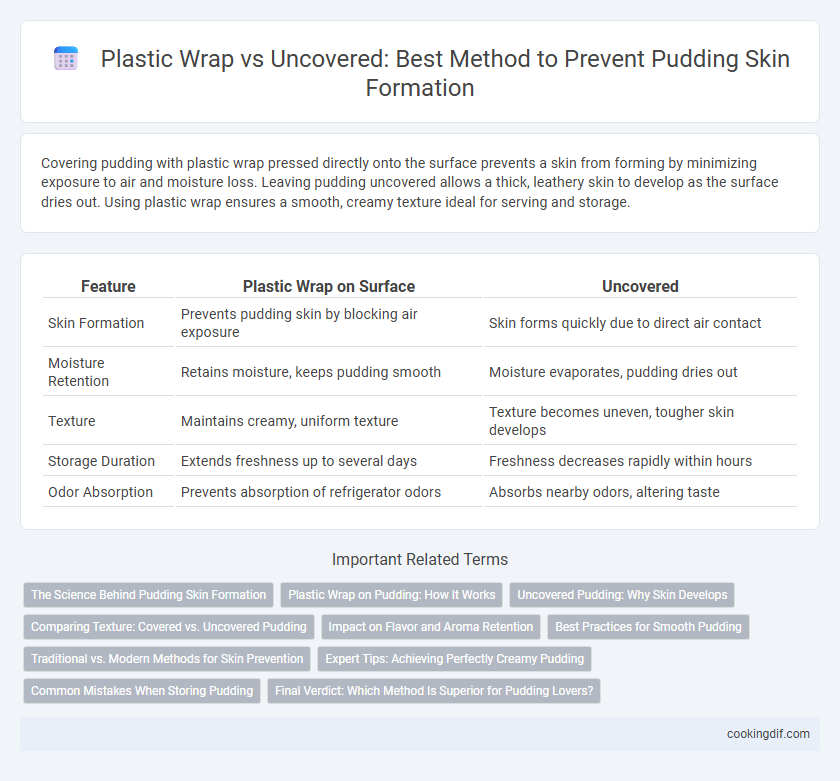Covering pudding with plastic wrap pressed directly onto the surface prevents a skin from forming by minimizing exposure to air and moisture loss. Leaving pudding uncovered allows a thick, leathery skin to develop as the surface dries out. Using plastic wrap ensures a smooth, creamy texture ideal for serving and storage.
Table of Comparison
| Feature | Plastic Wrap on Surface | Uncovered |
|---|---|---|
| Skin Formation | Prevents pudding skin by blocking air exposure | Skin forms quickly due to direct air contact |
| Moisture Retention | Retains moisture, keeps pudding smooth | Moisture evaporates, pudding dries out |
| Texture | Maintains creamy, uniform texture | Texture becomes uneven, tougher skin develops |
| Storage Duration | Extends freshness up to several days | Freshness decreases rapidly within hours |
| Odor Absorption | Prevents absorption of refrigerator odors | Absorbs nearby odors, altering taste |
The Science Behind Pudding Skin Formation
Pudding skin forms when the surface liquid loses moisture and proteins denature, creating a thin film as it cools. Covering pudding with plastic wrap prevents airflow, reducing evaporation and effectively stopping skin formation. Uncovered pudding allows water to evaporate, leading to the development of this skin due to protein coagulation and surface tension changes.
Plastic Wrap on Pudding: How It Works
Plastic wrap on pudding creates an airtight seal that prevents moisture from evaporating, effectively stopping a skin from forming on the surface. By minimizing exposure to air, the plastic wrap maintains the pudding's smooth texture and creamy consistency. This method is widely recommended for custard-based puddings where a delicate skin often develops during cooling.
Uncovered Pudding: Why Skin Develops
When pudding is left uncovered, the exposed surface cools and forms a skin due to moisture evaporation and protein coagulation. This skin results from the concentration of milk proteins and starches as water escapes during cooling. Preventing skin formation requires covering the pudding with plastic wrap to maintain moisture and inhibit surface drying.
Comparing Texture: Covered vs. Uncovered Pudding
Plastic wrap pressed directly onto the surface of pudding prevents a skin from forming by creating a moisture barrier, resulting in a smooth and creamy texture. Uncovered pudding develops a firmer, slightly rubbery skin due to evaporation and surface drying. This skin alters the pudding's mouthfeel, making the covered version preferable for maintaining consistent texture.
Impact on Flavor and Aroma Retention
Covering pudding with plastic wrap directly on the surface significantly enhances flavor and aroma retention by preventing exposure to air, which can cause oxidation and moisture loss. An uncovered pudding surface might develop a skin and lose volatile aromatic compounds, leading to diminished taste intensity and a less appealing scent. Using plastic wrap ensures the pudding maintains its original creamy texture and preserves the full spectrum of its flavor profile.
Best Practices for Smooth Pudding
Covering pudding with plastic wrap directly on the surface prevents a thick skin from forming by minimizing air exposure and retaining moisture. Leaving pudding uncovered allows evaporation, causing a dry film that alters texture and appearance. For best results, press a piece of plastic wrap gently onto the pudding's surface immediately after cooking to ensure a smooth, creamy consistency.
Traditional vs. Modern Methods for Skin Prevention
Covering pudding with plastic wrap directly on the surface prevents skin formation by minimizing evaporation and air exposure, a modern method favored for efficiency and consistency. Traditional techniques involve frequent stirring during cooling to inhibit skin formation but are labor-intensive and less effective. Modern plastic wrap usage ensures a smooth, uniform pudding texture while preserving moisture better than uncovered or manually stirred preparations.
Expert Tips: Achieving Perfectly Creamy Pudding
Plastic wrap placed directly on the pudding surface prevents a skin from forming by creating an airtight seal that retains moisture. Leaving pudding uncovered exposes it to air, causing a thick, rubbery layer to develop as the top cools and dries. Expert tips recommend pressing plastic wrap gently onto the pudding while it's still warm for flawlessly creamy texture without unwanted skin.
Common Mistakes When Storing Pudding
Covering pudding with plastic wrap pressed directly onto its surface prevents a skin from forming by sealing in moisture and limiting air exposure. Leaving pudding uncovered or covering it loosely allows evaporation, leading to a thick, rubbery skin on top. A common mistake is using plastic wrap without touching the pudding's surface, which fails to trap moisture effectively and results in undesirable texture changes.
Final Verdict: Which Method Is Superior for Pudding Lovers?
Covering pudding with plastic wrap pressed directly onto the surface prevents a skin from forming by creating an airtight seal that traps moisture. Leaving the pudding uncovered allows evaporation, resulting in a thick, unwanted skin that affects texture and mouthfeel. For pudding lovers seeking a smooth, creamy consistency, plastic wrap is the superior method to maintain optimal quality.
plastic wrap on surface vs uncovered for pudding skin prevention Infographic

 cookingdif.com
cookingdif.com